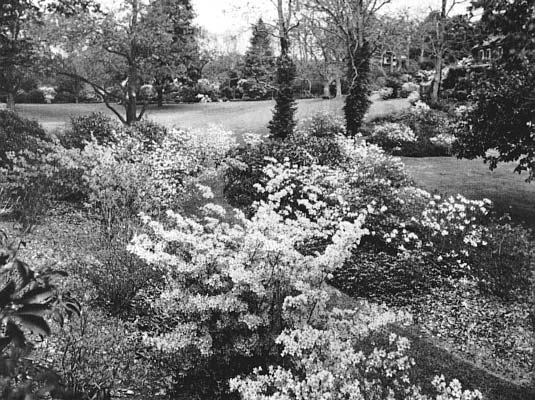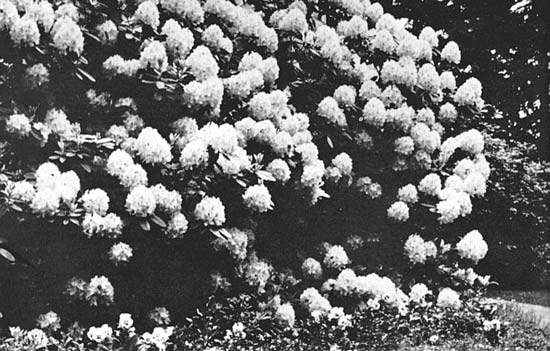QBARS - v16n4 When a Rhododendron Breeder Dies, What Happens to His Hybrid Seedlings?
When A Rhododendron Breeder Dies, What Happens To His Hybrid Seedlings?
John C. Wister, Swarthmore, Pa.

|
|
Fig. 37. A section of the grounds at the Dexter Estate
Dexter Estate photo |
By the very nature of his work the plant breeder lives in the future. His mind is constantly racing ahead-five, ten or twenty years to the glorious day when the plants raised from the crosses he has just made, as well as from the crosses he plans to make in future years, will all be in bloom.
He is thinking of how many fine plants he can grow from cuttings from each selected seedling and wondering when and where these can be distributed. He may be thinking of what return they will bring to him after the years of labor whether this return be in money, or in the acclaim of his fellow Rhododendron breeders, or just in the plain satisfaction of having produced a superior specimen of a plant that he loves.
But the breeder may not live the needed ten or twenty year; to which he looks forward - what then?

|
|
Fig. 38. A Barto hybrid of unknown parentage
growing in the Editor's garden. |
Will his plants perish soon after him and will his work in striving to produce superior varieties have been in vain? Will what he has done be forgotten?
Several members of the American Rhododendron Society have asked these questions in recent meetings. They have discussed how the breeder can direct the distribution of his best plants after his death and prevent the distribution of those which might. injure his reputation as a breeder.
These members remember the years of delay in the propagation of, and distribution of, and even the loss of some of, the finest achievements of two very remarkable recent Rhododendron: breeders. The stories of these two men have been published in these pages, but will bear brief repeating. In Oregon, James Barto worked with rhododendrons for fifteen years. He collected many rare species and varieties and used them for breeding. Just before his death in 1940 many of his plants and all of his records were destroyed in a fire, but many other plants did survive. Mrs. Barto apparently did not know which of these were good or poor and sold them as the chance offered. Some were so commonplace that in subsequent years rhododendron fanciers, seeing a dud in a breeder's garden, would refer to it as a "Barto." This was most unfair to the man who had done much wonderful work and produced some magnificent new hybrids. Only now, after twenty years is his work coming to be appreciated through the patient work of Dr. Carl Phetteplace who has searched out the best of his seedlings and written about them and about their raiser.
In Massachusetts, Charles O. Dexter, devoted the twenty years before his death in 1943 to rhododendron breeding. He raised about 10,000 hybrid seedlings a year. Most of them, of course, were ordinary or non-descript but they were attractive in mass planting and made such a spectacle on his estate that he became famous locally and had many visitors in the flowering season. He allowed himself to be talked into giving to friends, or selling some of the poorer specimens as well as untold thousands of small seedlings in flats. This custom was continued after his death by his widow and, after his place was sold, by the new owners. In this way Dexter plants were scattered along the Atlantic seaboard from the New Hampshire border to the Carolinas and most of them were so commonplace that they all but destroyed Mr. Dexter's reputation as a breeder.
There were, however, among these seedlings some truly magnificent new hybrids of which perhaps a hundred should have been named, propagated on a large scale and distributed. If that had been clone, Mr. Dexter would now be regarded as one of the greatest rhododendron breeders. However, the dead weight of the poorer plants which had been distributed, was so great, that only through the efforts of a small group of Rhododendron Society members under the leadership of Dr. Clement G. Bowers, were the present locations of some of these special clones discovered so that plants propagated from them could be brought together to be tested. About half a dozen have been named and introduced and nearly a hundred others are awaiting final judging. About twenty years have gone by and nobody knows how many other outstanding hybrids have been lost to posterity.
The Rhododendron Society members who have discussed this matter, agree that the Society should urge its breeders to make definite provisions in their wills about their plants. One of these provisions should be that the poorer or ordinary seedlings should not be distributed. It is more difficult to make other general recommendations because the different breeders will, of course, have different ideas of what should be done with their seedlings.
A professional breeder with a nursery can certainly arrange that his nursery carry on his work. A breeder on a smaller scale may wish to have a member of his family or a close friend take over his plants and continue the work with them. Still another breeder will think the only thing to do would be to offer his plants to a Rhododendron test garden or to an arboretum or public park where they would continue to grow for people to see and enjoy.
Many breeders will feel that it is necessary that the plants they leave should bring some monetary return to their heirs. It will be difficult to give concise directions how that may best be achieved by heirs having no technical knowledge of Rhododendrons, their breeding, their propagation and distribution.
With all these complexities, it is however abundantly clear that the first thing needed is to have each individual breeder give some definite directions. It is not enough to give these orally, although in the case of Mr. Dexter and Mr. Barto such oral directions would undoubtedly have been of help to their widows. The directions should be in writing and the breeder should make them himself and then turn them over to his lawyer to draft in legal form and place in his will.
It is hoped that this short article will cause present day breeders to think about this problem and to write out such directions. It is sincerely to be hoped that in the future there will not be such lamentable losses of plants and of reputations as in the case of James Barto and Charles Dexter.
